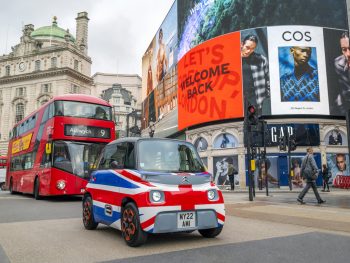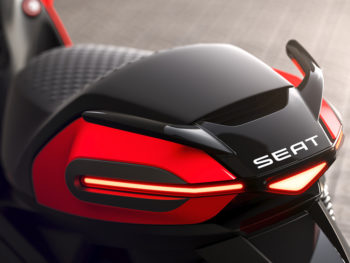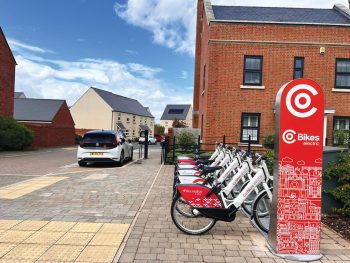On the move: The changing face of mobility
Today’s mobility options for drivers stretch way beyond being tied into a passenger car for a fixed period of time. More alternatives have appeared that offer major cost, efficiency and flexibility advantages

One size certainly doesn’t fit all when it comes to business mobi
INDUSTRY INSIGHT
Mark Newberry, commercial director, Europcar Mobility Group UK
One size doesn’t fit all
Without sounding like a contestant on ‘Strictly Come Dancing’, the fleet sector is on a journey. In the past three years – from the shock of lockdowns to a frozen supply chain and now escalating operating costs – any fleet manager worth their salt has had to pivot, repeatedly. And the reality is, the picture isn’t going to change that much for 2023, with the added pressure of addressing sustainability targets.
Right now, one size certainly doesn’t fit all when it comes to business mobility. Probably the biggest shift has been the need to adapt to the hybrid working model. Employees who previously considered a company vehicle a necessity for every day, now might prefer access to flexible mobility solutions on-demand.
That approach has added another complication to the life of the fleet manager. Car share, car clubs and pool fleets have all become more important components of fleet strategies, with all the logistical challenges they bring.
Finding the right partners for flexible business mobility is now, therefore, about much more than getting a great deal on the price. Of course, that’s important – but so too is knowing that a partner has access to the right mix of mobility, from hourly and daily to monthly and longer; that it can be managed easily with good technology and that insight into vehicle usage and emissions can be part of the service.
On the road to zero
A partner that can help a business transition to lower emissions is also crucial right now – and one that recognises that the path to zero – is not necessarily straightforward. A recent study we carried out among company car drivers found that over one third would consider changing jobs if they felt their employer wasn’t doing enough to be sustainable and tackle climate change.
The industry and UK fleet sector is learning more all the time about electric and sustainable motoring, which is why it’s important to find a partner that can help you take those initial steps and learn from real-world experiences. Then, once ready, that partner can support a broader wholesale shift to zero.
Mobility that makes a meaningful difference
Advances in technology – on and off the road – make the potential for business mobility to make a truly meaningful difference to an organisation’s operations, staff wellbeing and profitability all the more exciting. The key is to find the right partners to achieve that potential.
CHANGE HERE FOR NEW MOBILITY OPTIONS

Christopher Caddick, head of business development, JCT600 Vehicle Leasing Solutions
By Christopher Caddick, head of business development, JCT600 Vehicle Leasing Solutions (VLS)
As we continue to see wider business travel considered under an overall mobility strategy – rather than separate travel, car and operational vehicle policies – the industry is once again innovating to support businesses and their employees. The obvious evidence of this is the growth in Mobility as a Service (MaaS) solutions and the use of travel budgets, sometimes as a replacement for a perk company car. While this approach will work for some employers and employees, a one-size-fits-all approach is not going to work for everyone.
Like cash allowances, offering employees a travel budget could be one way for businesses to put a simple and cost-controlled solution in place to cover work travel costs. However, it’s important to understand each employee’s travel requirements, what they value as an individual in business travel, and ultimately what is ‘in it for them’.
Providing employees with a car has always been more than just covering business miles – it’s a ‘perk’ or benefit for that particular role and a hugely emotive one. Following the ‘dash for cash’ the industry is seeing a huge change in employee behaviour and a return to the company car. This is heavily supported by low BiK charges on electric vehicles and the re-popularisation of salary sacrifice schemes, coupled with changes to buyer behaviour and individual appetite to risk.
A hybrid approach could work well for businesses wanting to offer employees a valuable incentive. Providing a choice of options such as a travel budget to use on any form of transport or a vehicle funded via salary sacrifice, will give the employee greater flexibility and choice over what they need from a travel point of view.
From the employee’s perspective, they need to fully understand all costs involved whatever the option they choose. This is exactly what JCT600 does with its customers and their employees via the Origo driver portal and the ongoing consultation.
In considering the overall business mileage mobility strategy, MaaS products will increase in popularity, but there will still be a desire for a car that can be used not only for business use but also commuting and private use too. Businesses that lead with the employees’ needs will excel in the future of mobility.
AUTOMOTIVE OPTIONS: CITROËN AMI

Citroën is turning its attention to the potential demand for the Ami among fleet customers
As fleet propositions go, the Citroën Ami should be a laughing stock. The electric two-seater has a 28mph top speed, no heater or stereo and is left-hand drive only with a range of 46 miles. Instead, however, it might turn out to be one of the smartest commercial decisions that Citroën in the UK has ever made.
At first sight, the Ami makes sense as a retail proposition. Once the French manufacturer built a website to take expressions of interest in the Ami, it took just 22 minutes before the first UK order came in. That order was swiftly followed by more – many more, in fact. At the time of writing, Citroën has 1,625 active orders and reservations with an eye-watering 1,600 test drive requests at dealers.
So far however, Citroën openly admits that much of that initial focus had been on private buyers, but now it is turning its attention to the potential demand for the Ami among fleet customers, with its team already talking to several prospective customers, many of whom are new to Citroën and indeed to car companies entirely.
It doesn’t take much, or indeed any, imagination to think about potential uses for the Ami either. They’re already used by the post office in Morocco (where the Ami is built), by airport authorities in Portugal and by the Suez water treatment company in France.
Widen your mind’s horizons still further and the possibilities are almost endless – food delivery companies, holiday parks, parcel or last-mile delivery firms, city car-sharing schemes, the list goes on and on. With more carrying capacity than a scooter and cheaper to run than a small car, you don’t need Mensa-membership to see the potential demand, particularly with the Cargo version that loses the passenger seat for a built-in 260-litre storage box.
There are other added bonuses too. The first is that as the Ami has very little tech on board, it uses very few silicon chips, which obviously helps supply under the current industry challenges. The second is that as the Ami is such a unique proposition in the market – as a result Citroën is being approached by many customers who are new to the brand.
Nat Barnes
SEAT MÓ SCOOTER

MÓ electric scooter from SEAT
Don’t fancy sticking to four wheels, but still mindful of the shift to electric vehicles? An electric scooter might be the way to go. And no, not one of the e-scooters that are still yet to be legalised across the UK – we’re talking a Vespa-type affair that might pique the interest of eco-conscious mods and rockers.
One option in this (growing) segment is the MÓ from SEAT. With the electric motor and 5.6kWh battery providing 240Nm of torque and up to 85 miles of range, the MÓ is a fantastic vehicle that offers all of the advantages of a ICE-powered scooter, but with the added benefit of being emission-free. Another advantage is the near-silent operation (there’s still a bit of road noise), which takes some getting used to, given your brain expects a vehicle like this to emit a specific and recognisable sound.
With the equivalent of a 125cc standard bike, it’s an electric vehicle with plenty of power when you twist the grip to set off from a standstill. That power keeps on going – most entertaining when selecting Sport mode (City and Eco modes are also available). The choice of power delivery is one of the many simple things about the MÓ. Operation is seamless and the on-screen menus all make sense – all the information you’d need is available with one or two presses of a button. There’s also elements you’d expect to see on a car, such as USB connectivity and daytime running lights.
Recharging isn’t an issue, either. Simply lift up the handle on the side of the battery pack (the complete unit is a bit like a small suitcase with wheels), pull it out and plug the 3-point pin connector into the mains to recharge. At 40kg, it’s not overly heavy, so moving it to the desired charging location shouldn’t be an issue, even if that means taking it up stairs or down the road. The charging process can be completed in as little as six hours.
The overwhelming feeling you get from riding an electric scooter like the MÓ is enjoyment. One thing to bear in mind is the need to complete a CBT (compulsory basic training) course before going anywhere near the bike. Or, if you’ve done one, remember that they only last for two years, so you might need to contact one of the many test centres around the country. It’s a one-day course – a mixture of practical and classroom-based work – that should be straightforward. If your favourite (current) Fleet World editor can get it done, then anyone can!
John Challen
ELECTRIC WHEELS
Most people return from a holiday with a couple of souvenirs, a novelty hat and sunburn. For Chris Hurdle, managing director of Electric Wheels, it was a motorbike. Not just any motorbike, mind you – this was an electric motorbike. Perhaps not that unusual today, but in 2018 it was something of a novelty. That novelty soon turned into a business however, when he kept being asked lots of questions while using it for his day job working in outdoor events.
It was enough to convince him to import the electric motorbikes as a business and sell them and so Electric Wheels was born alongside business partner Tony Abel. The ideas for the business didn’t stop there however. A chance meeting with a customer with an electric Utility Terrain Vehicle (UTV) and a short test drive, convinced Hurdle to focus on them instead. While similar in concept to quad-bikes, UTVs actually have two seats side-by-side and are generally used more for work by farmers and outdoor workers.
Today, Electric Wheels both sells and rents electric UTVs in all their forms and business is booming. Hire numbers have doubled while sales have quadrupled and both sides of the business are expected to double in 2023.
It’s not hard to see why either. On the sales side, UTVs range in price from £14,000 up to £35,000, the latter with four-wheel drive, tow bar, winch, 40mph top speed and two differential locks. Farmers buy them mainly with a consideration towards sustainability but they’re also – obviously – so much quieter than their diesel counterparts. The cost of fuel and servicing is considerably lower too. Other customers include everyone from those working underground to the Ministry of Defence and night security at camping and caravan sites.
By comparison, the hire side of the business includes everything from music festivals to RHS flower shows and many other annual major outdoor events. “During the set up for large outdoor events, the UTVs are used as workhorses for carrying tools, putting up fences and transporting workers around the site,” explains Hurdle. “Then during the event, they’re used by people to get around and for staff to liaise with each other, plus catering and cleaning purposes, while during the break down, it’s just the same as the set-up, but in reverse.”
While the average hire at most events is eight UTVs, many will have between 30 and 40 (the largest is 54).
Nat Barnes
MOBILITY AND CHARITY…
A Devon mobility hub delivered by social enterprise Co Cars has been recognised for promoting greener journeys with a gold award from the national shared transport charity, CoMoUK.
The site at Seabrook Orchards in Topsham, near Exeter, has CoMoUK’s highest standard of accreditation for a new development and is only the second such facility to be officially recognised by the charity.
Mobility hubs can take several different forms, ranging from larger interchanges in busy city centres to mini stations which are tailored to suburban or rural areas. The Seabrook Orchards facility was launched by not-for-profit social enterprise Co Cars in May and is the first at a housing development in Exeter.
Powered by by 100% renewable energy from Good Energy, the site features a dedicated charger for the Co Car, plus a public charger, both supplied by Econetiq. It is located just 100m from dedicated cycle routes and the nearest bus stop, with the 57 bus route providing frequent connections to both Exeter and Exmouth. Since the hub opened there have been almost 2,000 e-bike rentals and more than 20% average car utilisation.
“Mobility hubs are exciting ways to boost sustainable transport, improve public health and save people money,” says Richard Dilks (left), chief executive of CoMoUK. “The combination of the cost-of-living and climate crises make it more important than ever to properly manage space for shared, active and public transport as an alternative to private car use.
Meanwhile, Nic Eversett, MD of Co Cars, adds: “Mobility hubs make it very easy for people to make more sustainable travel choices – it’s been fantastic to see residents embrace the services it offers. Moreover, the hub has also sparked the interest of our stakeholders, including on-site visits to find out more. We look forward to launching more in the years to come.”














